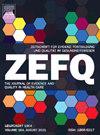[评价德国难民集体收容中心医疗文件的数字化:一项定性研究]。
IF 1.7
Q4 HEALTH POLICY & SERVICES
Zeitschrift fur Evidenz Fortbildung und Qualitaet im Gesundheitswesen
Pub Date : 2025-09-01
DOI:10.1016/j.zefq.2025.06.005
引用次数: 0
摘要
背景:作为德国法定卫生服务限制的一部分,许多难民最初在最初接待中心的医疗门诊接受医疗护理。所提供的护理因中心和可用资源的不同而有很大差异。关于这些情况下难民的健康状况或保健需要的可靠资料仍然很少。在此背景下,海德堡大学医院在联邦卫生部的资助下开发了一款电子医疗记录(EMR)软件(难民护理管理器[Ref.Care])。该开发始于2016年,该软件已在三个联邦州的40多个接待设施中实施。一方面,该软件使以标准化形式数字化记录医疗过程成为可能,另一方面,该软件可以匿名处理基于指标的治疗数据。已经对电子病历的影响进行了广泛的研究。在接待中心为难民提供的保健服务很少列入这项研究。因此,本研究从软件使用者的角度考察了电子病历对患者护理的贡献,以及电子病历在软件和实施策略方面的改进潜力。方法:2018年,对德国接待机构门诊诊所的30名服务提供者进行半结构化专家访谈。访谈指南主要关注新引入的电子病历的满意度、接受度和可用性等主题。根据库卡兹的说法,采访被数字化记录,假名化,逐字转录,并基于内容结构内容分析进行分析。使用MAXQDA 20支持分析。结果:在培训期间和培训结束后,通过与实习团队的亲自接触,促进了电子病历软件的引入。提供的材料后来很少使用。在日常护理中,使软件适应治疗环境的可能性被认为是特别积极的。技术上的困难和缺少的特性,比如缺乏与其他软件产品的互操作性,有时会使Ref.Care难以应用。从受访者的角度来看,该软件在提高护理质量和提高文档编制效率方面做出了重要贡献。人们还积极地看待进一步将数据用于研究目的的选择,并确定对特定专业群体和用户需要的适应性是一个潜在的改进领域。结论:通过对Ref.Care软件引入的前期评估,电子病历在难民护理设置中的优缺点与常规护理非常相似,不同软件产品之间缺乏互操作性的问题也体现在这里。为了确保数字干预措施的接受和使用,参与性发展进程和适应的实施战略将是有益的。本文章由计算机程序翻译,如有差异,请以英文原文为准。
Evaluation der Digitalisierung der medizinischen Dokumentation in Sammelunterkünften für Geflüchtete in Deutschland: eine qualitative Studie
Background
Many refugees initially receive medical care in the medical outpatient clinics of initial reception centers as part of the statutory health service restrictions in Germany. The care on offer varies greatly depending on the center and the resources available. Reliable information on the health status or health needs of refugees in these contexts remains scarce. Against this backdrop, an electronic medical records (EMR) software (Refugee Care Manager [Ref.Care]) was developed at Heidelberg University Hospital with funding from the Federal Ministry of Health. The development began in 2016, and the software has since been implemented in over 40 reception facilities in three federal states. On the one hand, the software makes it possible to document medical treatments digitally in a standardized form and, on the other hand, to process the treatment data anonymously and based on indicators. Extensive research into the effects of EMRs has already been carried out. Health care provided for refugees in reception centers has rarely been included in this research. This study therefore examines 1) the contributions that EMRs can make to patient care from the perspective of the software users and 2) the potential for improvement with regard to both software and implementation strategy.
Methods
In 2018, semi-structured expert interviews were conducted with 30 service providers from outpatient clinics in reception facilities in Germany. The interview guide focused on the topics of satisfaction, acceptance, and usability of the newly introduced electronic medical records. The interviews were digitally recorded, pseudonymized, transcribed verbatim, and analyzed based on content-structuring content analysis according to Kuckartz. MAXQDA 20 was used to support the analysis.
Results
The introduction of the electronic medical records software was facilitated by personal contact with the practice teams during and after the training courses. The materials provided were rarely used afterwards. In everyday care provision, the possibility to adapt the software to the treatment context was seen as particularly positive. Technical difficulties and missing features, such as lack of interoperability with other software products, sometimes made it difficult to apply Ref.Care. From the respondents’ point of view, the software makes an important contribution to improving the quality of care and increasing efficiency in terms of documentation. The option to further use the data for research purposes was viewed positively as well, and adaptability to specific professional groups and user needs was identified as a potential area of improvement.
Conclusion
The early evaluation of the introduction of the software Ref.Care shows that the advantages and disadvantages of electronic medical records in the setting of care for refugees are very similar to those in routine care, and the problem of the lack of interoperability between different software products is also reflected here. To ensure acceptance and use of digital interventions, a participatory development process and an adapted implementation strategy would be beneficial.
求助全文
通过发布文献求助,成功后即可免费获取论文全文。
去求助
来源期刊

Zeitschrift fur Evidenz Fortbildung und Qualitaet im Gesundheitswesen
HEALTH POLICY & SERVICES-
CiteScore
1.90
自引率
18.20%
发文量
129
 求助内容:
求助内容: 应助结果提醒方式:
应助结果提醒方式:


